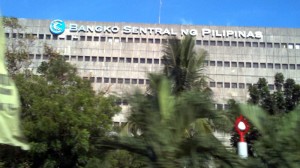
The amount of foreign money that left the country declined in April, suggesting the continued stabilization of global financial markets as investors turned less jittery over policy changes in advanced economies like the United States.
Documents released by the Bangko Sentral ng Pilipinas (BSP) showed the country’s balance-of-payments (BOP) position improved last month but remained in a deficit despite the perceived attractiveness of the country as an investment destination.
“The deficit was due to the servicing of foreign exchange debt and the BSP’s foreign exchange operation,” BSP Governor Amando M. Tetangco Jr. told reporters Monday.
A BOP deficit of $19 million was posted in April, down from $340 million the month before. This was so far the lowest deficit this year, but still worse than the $274-million surplus in April 2013. A deficit means the country spent more dollars than it made during the month.
The outflows for the month were more than the dollars the country made from the foreign exchange deposits by the national government and the BSP’s own foreign exchange income. Other sources of foreign exchange included earnings from exports, the outsourcing and tourism sectors as well as remittances from overseas Filipino workers (OFWs).
Last year, foreign investments in the form of direct and portfolio placements were a major source of dollar income for the country. This source of foreign exchange has since dried up as fund managers shifted their focus away from emerging markets to advanced economies, which have started to recover from the 2008 global financial crisis.
Documents from the BSP showed a net outflow of $2.03 billion in foreign portfolio investments or “hot money” at the end of the first week of May as against the $2.1-billion net inflow in the same period a year ago. “Hot money” refers to placements in publicly traded shares, bonds and deposit certificates, which are easy to dump once investor sentiment sours.
The country’s foreign exchange reserves, which track the movement of the BOP, dipped to $79.6 billion at the end of April from $79.65 billion the previous month.


